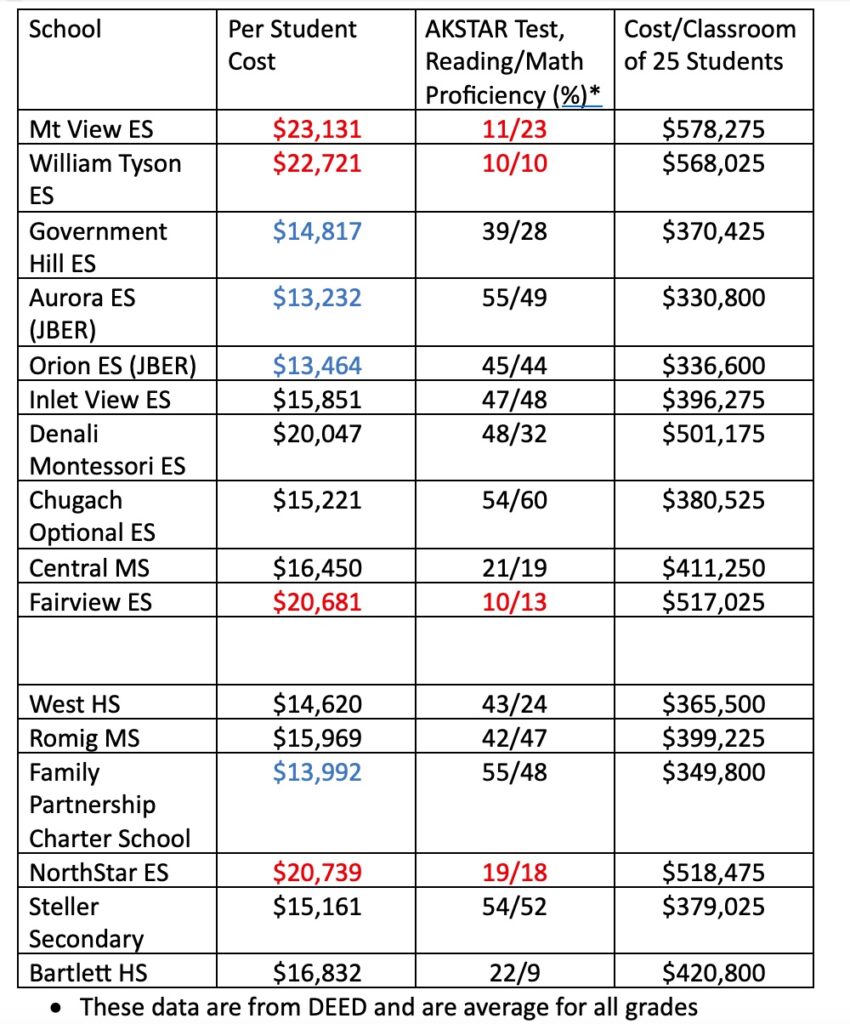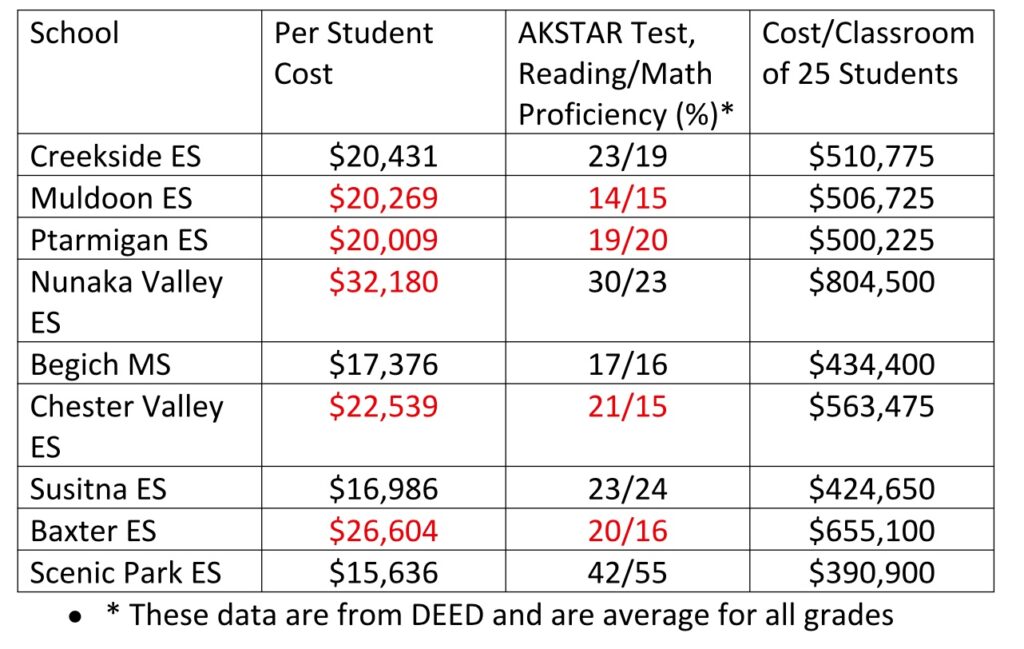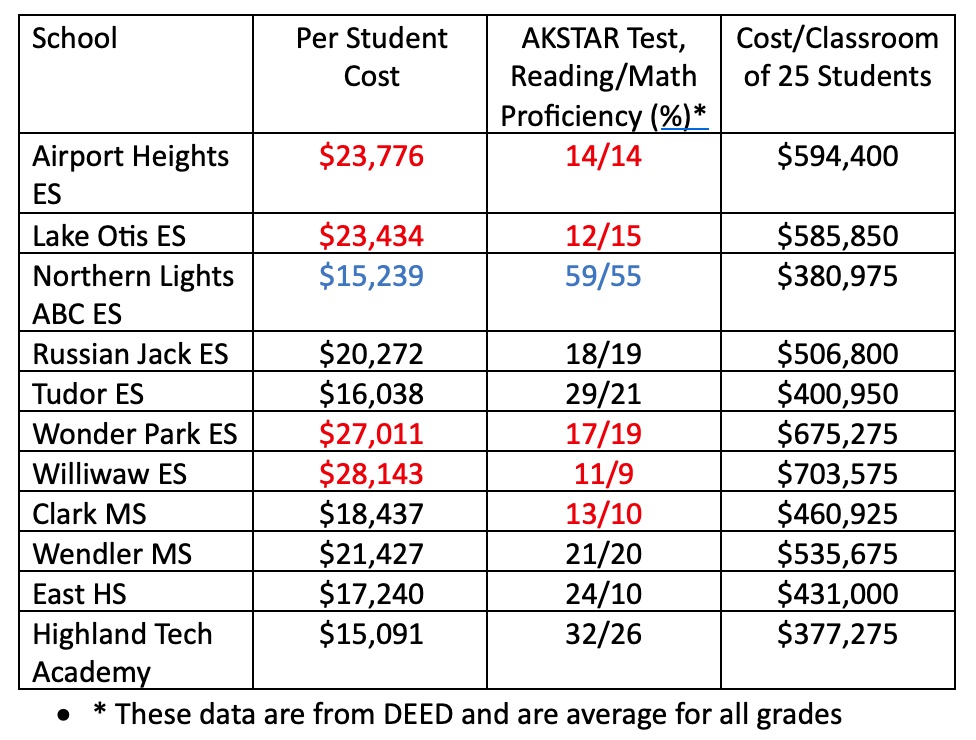By DAVID BOYLE
We are being inundated with messages and misinformation stating we need to just spend even more on our K-12 education system to get better student outcomes.
This misinformation comes from various parts of the Education Cartel: local school boards, local school administrators, the NEA-AK, the American Federation of Teachers, the Alaska Association of School Boards, the Alaska Council of School Administrators, the Coalition for Education Equity, and others.
Note that all these vocal supporters of increasing K-12 funding benefit directly and indirectly from this additional funding. In effect, the State of Alaska and local governments are funding these voices of “raise the BSA.”
Let’s look at three state senators who have voted for increasing the Base Student Allocation and voted for overriding the governor’s veto of raising the BSA. To them, more funding is the answer to improve Alaska’s K-12 system. And it seems to them that more funding is never enough. The goalposts get moved: They just need more, and they don’t want any accountability to measure success. They don’t want to measure the return on investment.
How are the students in Sens. Loki Tobin’s, Bill Wielechowski’s, and Forrest Dunbar’s districts doing on the standardized state tests, the AKSTAR?
How much are we spending on the schools in these three senators’ districts?
Here is a chart showing the schools in Sen. Tobin’s district (District I), the per student costs, and the average student AKSTAR results:

The above data show that the lowest performing elementary schools in Sen. Tobin’s district (Mountain View, William Tyson, Fairview, and North Star) have the highest per student funding. There is a direct relationship between more funding and lower student achievement in these specific schools. Then why would Sen. Tobin want more funding? Would she want the AKSTAR schools to go down?
On the other hand, two of the highest performing elementary schools, (Aurora and Orion) have the lowest per student cost — nearly $10,000 less per student than Mountain View Elementary School.
Another strong supporter of more K12 funding with no accountability for results is Sen. Wielechowski (District K). Let’s see how the schools in his district fare for spending and student outcomes:

The above data show that Senator Wielechowski has some of the lowest performing schools in the Anchorage School District. This is nothing new. For many years these schools have been the lowest performing schools. What has Sen. Wielechowski done to improve his district schools?
His current solution is to throw more money at the problem without demanding accountability for results. He also voted to raise the BSA and voted to override the governor’s veto that would decrease the increased funding in the Anchorage School District a mere $4.3 million. Mind you, there is still an increase in funding, just not as much as the cartel desires.
Does Sen. Wielechowski really believe that increasing the per student funding of $32,180 for Nunaka Valley Elementary School would ensure that more than 30% of its students could read at grade level?
He hasn’t ever insisted on any accountability for the extra spending so we shall never know if there is a correlation between student achievement and that spending increase.
Now let’s look at the schools in Sen. Dunbar’s district (District J). Dunbar also voted to increase the BSA with no accountability. Here are the per student costs and student test scores for those schools:

A very bright shiny school in Dunbar’s district is Northern Lights ABC school. This is one of ASD’s lottery schools. One must win the lottery to get their child into this great school. Trouble is, not every parent wins the lottery, and their children are relegated to the lower performing neighborhood schools.
Northern Lights’ students perform well above average in the AKSTAR tests. Maybe that’s because it uses Saxon Math and phonics in its curriculum. One wonders why other ASD schools don’t replicate these programs to teach their students. Teachers love to teach at Northern Lights because the students are behaved, motivated, and want to learn. The curriculum also works for the teachers and the students. Finally, parents are involved in this great school.
Note that less than 17% of the students in Airport Heights, Lake Otis, Williwaw, and Wonder Park elementary schools are proficient in reading.
Even worse, less than 14% of the students in Clark Middle School are proficient in reading. What will they do when they enter high school? Or are the other 86% of students destined to fail?
Dunbar believes that more funding is needed to help these students read at grade level.
What if parents in all these schools received at least one-third of the per student funding in the schools and chose the best education fit for their children? Maybe they could choose correspondence school. Maybe they could choose a private school. Maybe they could independently home school. Just maybe these students could really succeed in life.
The bottom line: More funding is not the answer to improve Alaska’s K12 system. Two years ago, the Alaska Reads Act passed into law. That’s when we learned that our university system was not teaching reading skills as a basic tenet of elementary school teacher’s curriculum.
Since then, the University of Alaska has added the science of reading to its elementary teacher program. And as bad as our reading scores are, they are improving.
The state cannot continue to throw more money at a broken system and expect different results. We must make targeted reforms that will improve our student outcomes.
The governor has called a special session in August to inform legislators what other states did to fix their underperforming schools. We need to open our minds and learn from others what works well to increase student achievement.
If we continue to focus on input (money) and not on output (student outcomes), then Alaska will continue to be mired in the morass of mediocrity while other States succeed in educating their children.
David Boyle is an education writer for Must Read Alaska.

The Alaska school’s utter failure in educating our students isn’t a funding issue.
It’s a method (look see versus phonics) and an emphasis (dei versus history/geography and civics) FAILURE.
The teachers and their union should be ashamed.
As parents and citizens we are disgusted.
Shame.
I totally agree.
Get back to the basics and do away with the fancy curriculum.
It worked for us in the 70s & 80s.
Graduated in the 80’s, alaska schools in the top 5 in the nation. Where are we now? Bottom feeders with the highest per student expenditures. Riddle me how this occurred?
Same here. We moved from FBX to the Midwest in the 80s and found our kids were way ahead of their peers in the Lower 48. What happened to Alaska?
Thank you for this David: Great article! You should share this with the three Senators; I’ll get some popcorn and we can sit back and watch their heads explode. 🤯🤯🤯
😁
David, excellent piece. Please do a similar review of the schools in the Fairbanks North Star Borough school district. Last I checked, not a single school had a majority of kids that were proficient in math, science and reading. Their per capita spends were well over $20,000 per kid.
The education lobby in Alaska is responsible for child abuse because they have failed our kids so badly.
Hear hear! 👍👍
All is going according to the democrat plan. Democrats have no shame, only an insatiable lust for power.
And subjugation of the masses, in ignorance, is a means to that end.
Thank you for the article above. I hasten to point out that the subject of accountability as it relates to Education spending isn’t anything new. Some 50 years ago I recall a conversation with Grace Butrovich on this subject. Grace pointed out that there was a time when she believed that funding Education would solve most of the problems in society. Sadly, she continued that she no longer believed that was the case. She went on to explain the correlation coefficient between increased education funding and worsening outcomes in education.
I recall her admonition, it’s not because of a lack of money, Bobby, it’s something else that needs to be corrected…
Sadly I’ve seen articles similar to this concerning the failure of the school system for decades in various Ak publications. No meaningful change has ever occurred. Only massive increase in spending. Its the poor performance of the teaching staff.
As the President of the Mat-Su Classified Employees Association and a director on the NEA-Alaska Board, I represent the people who keep Alaska’s schools running: the classroom paraeducators, secretaries, custodians, tech specialists, bus drivers, and maintenance crews. And while political talking heads point fingers from both sides, my members are the ones left cleaning up the mess—literally and figuratively.
Let’s be clear: the fight over public education in Alaska isn’t just about funding—it’s about ideology and power, and neither side has clean hands.
On one side, you have Senators Loki Tobin, Bill Wielechowski, and Forrest Dunbar—pushing for more education spending while refusing to work with the minority on real accountability. They voted to override the governor’s veto and raise the Base Student Allocation with no strings attached, no performance metrics, and no transparency. They didn’t offer compromise, didn’t listen to conservative reforms, and refused to make tough choices that could lead to long-term improvement.
On the other side, you’ve got Governor Dunleavy—whose vetoes and education policies clearly signal a different agenda: privatization. Instead of fixing the system, he’s trying to starve it into failure. He talks about student outcomes, but his solution is to gut funding, push parents into alternatives, and let public education collapse under the weight of unfunded mandates. He claims to be for reform, but too often it looks more like sabotage.
Here’s what both sides are missing: the people doing the real work—classified staff—are being cut out of the conversation entirely.
Every year, our members face layoffs, and increased workloads while politicians posture. Schools are asked to do more with less, but the same folks who cut our budgets turn around and blame us for poor test scores. We can’t build student success on broken foundations.
If we want to turn things around, we need leadership that:
Funds what works—like phonics-based reading, school safety, and vocational training
Demands accountability—with performance metrics for everyone, from superintendents to curriculum providers
Empowers front-line staff—not just top-down mandates from Juneau
Respects parent choice—while still investing in strong neighborhood public schools
Ends the political grandstanding—and puts students and staff first
The truth is: both the legislative Left and the executive Right are playing politics with Alaska’s children and workforce. Neither seems interested in listening to the people in the schools—the ones mopping floors, calming students in crisis, helping struggling readers, or running technology that keeps classrooms operating.
The bottom line? Alaska’s education system doesn’t need more ideological crusades. It needs balance, local leadership, targeted investment, and a willingness to listen to all stakeholders—not just the loudest or most well-connected.
Stop using education as a political pawn. Start treating it as the future of Alaska.
Rick …hell just froze over, now you’re in charge. You got all the money you need, you got Big Lou, the Louisville Sluggers running your HR shop so …no labor problems.
.
What exactly is on your 100-day list? Who goes, who stays, what goes, what stays, who slaps the choke chain on NEA, what’s the bottom line money-wise? Hundred days of you, kids are learning something …want to start learning something, be classically literate, patriotic, proud Americans, you got a team ready to make it happen?
.
You got all the money you need, but …what about rackets like Anchorage School Board who get away with padding contracts over a mil so they can hand ’em out to union shops around election time, freeze out open shops?*
.
Yeah, we’re talking to a union guy, but blowing money on such a scale …which could just as easily go to front line staff pay raises …seems rude somehow. Don’t laugh, this is half the battle, would Alaskan education be so expensive, would parent/taxpayers be so mad, if management didn’t blow money like it’s going outta style? Remember the last come-to-Jesus, independent forensic audit of state school system finances …oh, there wasn’t one, since like forever? Why not?
.
Knocking out rackets like that might go a long way toward cooling off ideological crusades, getting major cred with parent/taxpayers, proving you and yours aren’t the enemy. Now there’s a future for Alaska, yes?
.
Want to get control of the funding narrative, why not get wise to the False Claims Act, how front-line staff with inside knowledge of fraud, waste, and abuse can file qui tam lawsuits, maybe win tons of money in the process?
.
You seem like a gruff, but decent SOB, maybe you can talk to parent/taxpayers like they’re somebody, not at them, not down to them, and damn sure not in the style of the mealy-mouth perverts running the shi… show we have now.
.
You seem like somebody who’s been around the block, maybe even to places where school districts are -not- corrupt, overpriced, perverted, seemingly dedicated to functional illiteracy, child grooming, child mutilation, harboring illegal aliens.
.
How do you get that sh… stuff out of our schools, restore decent American cultural values to our schools, make them like success stories you’ve seen in other places? Yes, restore decent American cultural values to schools, how do you think the system ran off the rails in the first place?
.
Do we even freakin’ care how you do it as long as you do it? Like, no.
.
What they call the Mississippi Miracle, remember, hell froze over so you got muscle and money, what do you and yours need to make something like it happen in Alaska, you got people you need to make it happen?
.
Bottom line, Rick, the donnybrook’s not about “education”, it’s about justified antipathy toward an “education industry” the corrupt, depraved, monolithic fourth arm of government, seemingly accountable to no one, especially parent-taxpayers, for the overpriced, underperforming product it produces …and quite possibly the unjustified perception that you and yours are just rearranging deck chairs on that derelict.
.
There’s your assignment, Rick. You’re a union guy, expert negotiator …get the opposition on side, problem gets less, maybe goes away because at the very end of the day, most of us want the same thing, even if we need a little help articulating exactly what the same thing is.
.
So you wind up running the whole show, is there a problem with that?
.
One last favor, maybe a big ask, but we ask anyway. Recall “Houston schools taken over by Texas state agency, but Anchorage’s superintendent got out just in time”?** Boy Jharett fails in the Houston schools management team but winds up running Anchorage schools? How’d that happen? Texas agancy didn’t run him off, but he bails early? Sure and the union had no say in the hiring of this gem, but people talk …what are they saying?
.
To the point, what’ll it take to get that one down the road and replaced by someone possibly like yourself who knows what the hell he’s doing, what the end product’s supposed to look like?
.
Now you come back, tell us where we’re wrong, you can teach union reps how to rep the union, but can’t teach children how to rep themselves?
.
*https://mustreadalaska.com/anchorage-school-board-votes-for-construction-monopoly-by-labor-unions/
**https://mustreadalaska.com/houston-schools-taken-over-by-texas-state-agency-but-anchorages-superintendent-got-out-just-in-time/